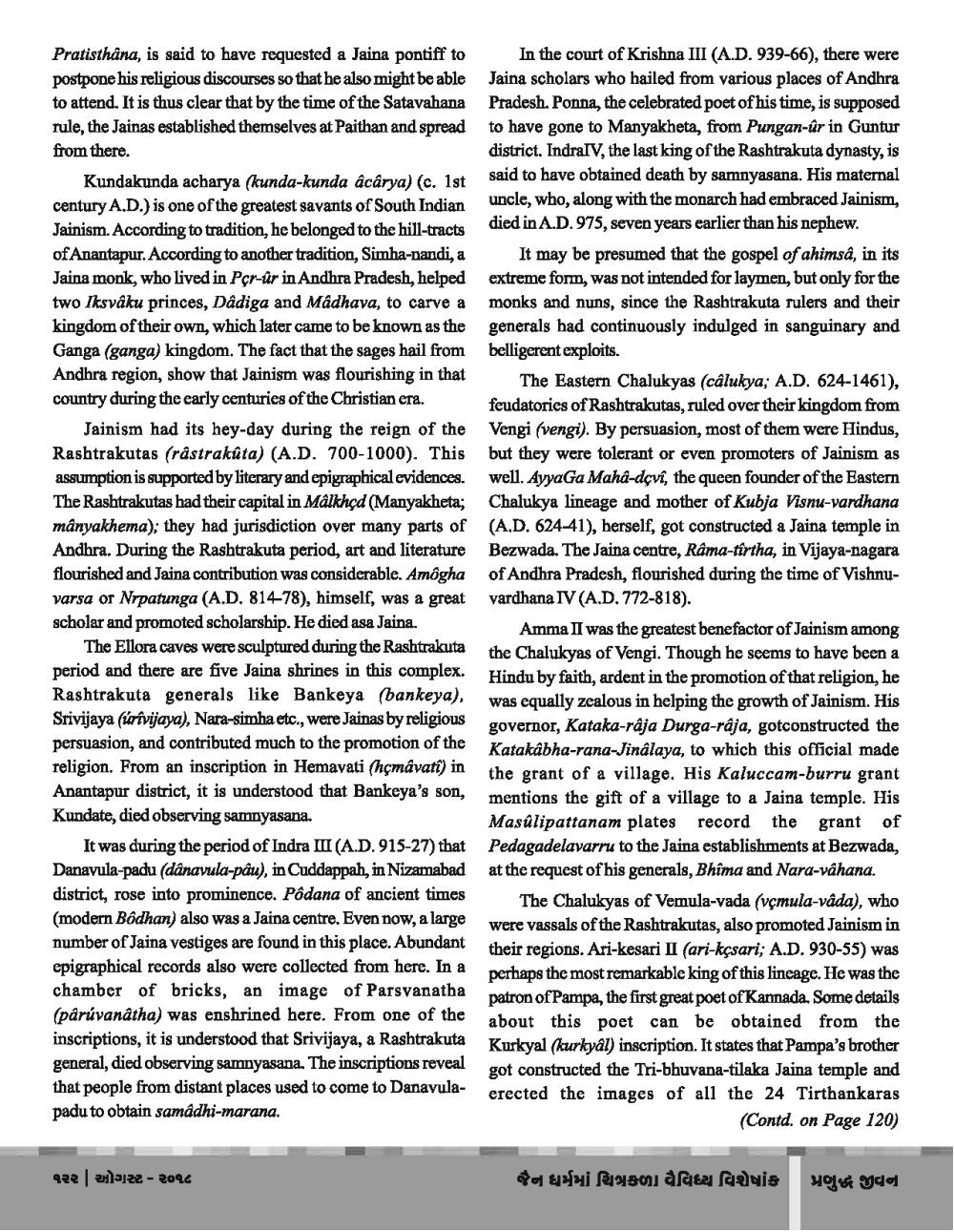________________
Pratisthana, is said to have requested a Jaina pontiff to postpone his religious discourses so that he also might be able to attend. It is thus clear that by the time of the Satavahana rule, the Jainas established themselves at Paithan and spread from there.
Kundakunda acharya (kunda-kunda àcarya) (c. 1st century A.D.) is one of the greatest savants of South Indian Jainism. According to tradition, he belonged to the hill-tracts of Anantapur. According to another tradition, Simha-nandi, a Jaina monk, who lived in Pcr-ür in Andhra Pradesh, helped two Iksvaku princes, Dâdiga and Madhava, to carve a kingdom of their own, which later came to be known as the Ganga (ganga) kingdom. The fact that the sages hail from Andhra region, show that Jainism was flourishing in that country during the early centuries of the Christian era.
Jainism had its hey-day during the reign of the Rashtrakutas (rastrakůta) (A.D. 700-1000). This assumption is supported by literary and epigraphical evidences. The Rashtrakutas had their capital in Malkhçd (Manyakheta; mânyakhema); they had jurisdiction over many parts of Andhra. During the Rashtrakuta period, art and literature flourished and Jaina contribution was considerable. Amôgha varsa or Nrpatunga (A.D. 814-78), himself, was a great scholar and promoted scholarship. He died asa Jaina.
The Ellora caves were sculptured during the Rashtrakuta period and there are five Jaina shrines in this complex. Rashtrakuta generals like Bankeya (bankeya),
bankeya), Srivijaya (ürivijaya), Nara-simha etc., were Jainas by religious persuasion, and contributed much to the promotion of the religion. From an inscription in Hemavati (hçmavati) in Anantapur district, it is understood that Bankeya's son, Kundate, died observing samyasana.
It was during the period of Indra III (A.D.915-27) that Danavula-padu (dânavula-pâu), in Cuddappah, in Nizamabad district, rose into prominence. Pôdana of ancient times (modern Bôdhan) also was a Jaina centre. Even now, a large number of Jaina vestiges are found in this place. Abundant epigraphical records also were collected from here. In a chamber of bricks, an image of Parsvanatha (pârúvanatha) was enshrined here. From one of the inscriptions, it is understood that Srivijaya, a Rashtrakuta general, died observing samyasana. The inscriptions reveal that people from distant places used to come to Danavulapadu to obtain samadhi-marana.
In the court of Krishna III (A.D. 939-66), there were Jaina scholars who hailed from various places of Andhra Pradesh. Ponna, the celebrated poet of his time, is supposed to have gone to Manyakheta, from Pungan-ûr in Guntur district. IndralV, the last king of the Rashtrakuta dynasty, is said to have obtained death by samnyasana. His maternal uncle, who, along with the monarch had embraced Jainism, died in A.D.975, seven years earlier than his nephew.
It may be presumed that the gospel of ahimsa, in its extreme form, was not intended for laymen, but only for the monks and nuns, since the Rashtrakuta rulers and their generals had continuously indulged in sanguinary and belligerent exploits.
The Eastern Chalukyas (câlukya; A.D. 624-1461), feudatories of Rashtrakutas, ruled over their kingdom from Vengi (vengi). By persuasion, most of them were Hindus, but they were tolerant or even promoters of Jainism as well. AyyaGa Maha-devi, the queen founder of the Eastern Chalukya lineage and mother of Kubja Visnu-vardhana (A.D. 624-41), herself, got constructed a Jaina temple in Bezwada. The Jaina centre, Râma-tirtha, in Vijaya-nagara of Andhra Pradesh, flourished during the time of Vishnuvardhana IV(A.D. 772-818).
Amma II was the greatest benefactor of Jainism among the Chalukyas of Vengi. Though he seems to have been a Hindu Hindu by faith, ardent in the promotion of that religion, he was equally zealous in helping the growth of Jainism. His governor. Kataka-râja Durga-râja, gotconstructed the Katakabha-rana-Jinalaya, to which this official made the grant of a village. His Kaluccam-burru grant mentions the gift of a village to a Jaina temple. His Masûlipattanam plates record the grant of Pedagadelavarru to the Jaina establishments at Bezwada, at the request of his generals, Bhima and Nara-váhana.
The Chalukyas of Vemula-vada (vçmula-vâda), who
The Chalukvas of Vemula-vada (vem were vassals of the Rashtrakutas, also promoted Jainism in their regions. Ari-kesari II fari-kcsari: A.D. 930-55) was perhaps the most remarkable king of this lineage. He was the patron of Pampa, the first great poet of Kannada. Some details about this poet can be obtained from the Kurkyal (kurkyál) inscription. It states that Pampa's brother got constructed the Tri-bhuvana-tilaka Jaina temple and erected the images of all the 24 Tirthankaras
(Contd. on Page 120)
વરર| ઓગસ્ટ- ૨૦૧૮
જૈન ધર્મમાં ચિત્રકળા વૈવિધ્ય વિશેષાંક પ્રબુદ્ધ જીવન




